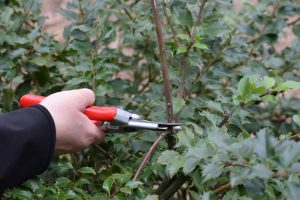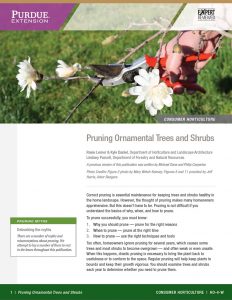Now’s a good time to survey your landscape and decide what needs pruning following potential freeze injury late this winter, keeping in mind that not all plants need to be trimmed. Pruning generally stimulates new buds to develop and break dormancy, so this year we recommended delaying pruning to reduce freeze injury.
We had mild conditions through midwinter, which caused some plants to emerge early from dormancy. The more recent temperatures in the teens and low 20s will likely result in some of these plants having dead buds and twig dieback. It is still a bit early to know the extent of the damage, and there’s still potential for additional weather related issues as we are just heading into spring.
Pruning isn’t difficult, but there are proper techniques to keep in mind. Late winter or early spring, before new growth begins, is generally considered the optimum time to prune most plants. This is when a plant’s wounds heal quickly, without threat of insect or disease infection. However, plants that bloom in early spring, such as forsythia, magnolia and crabapple, should be pruned later in spring after their blooms fade. These early bloomers produce their flower buds on last year’s wood, so pruning early will remove many potential blooms. Freeze injury may have already spoiled the show – we’ll know soon.
Trees that have large quantities of sap in the spring, such as maple, birch and dogwood, are not harmed by early spring pruning but can be pruned in midsummer or late fall to avoid the sap bleeding.
In general, landscape plants should be pruned to maintain or reduce their size, to remove undesirable growth, to remove dead or damaged branches, and to rejuvenate older plants to produce more vigorous foliage, flowers and fruits. In some cases, pruning is necessary to prevent damage to life and property.
In most cases, it is best to allow a tree or shrub to develop its natural shape as much as possible. However, removing selected branches because they are weak or formed at a poor angle to the trunk will help the rest of plant receive more sunlight. Thin this type of growth by removing unwanted branches at their point of origin. Make the cut just beyond the branch collar, which is the ridge of bark that surrounds the junction of that branch to its point of origin.
If reduction in size is desired, a technique called “heading back” is recommended. Shorten branches by cutting back to a healthy side bud or branch that is pointing in the direction you want future growth to occur. Make a cut about one-fourth inch above the bud or branch.
Evergreen trees, such as firs, pines and spruce, are not pruned by the same methods as other plants. They can be encouraged to produce stockier trees by pinching the “candles” of new growth, which emerge in late spring. Pinch out one-half of the candle when it reaches approximately 2 inches long. Use a sharp knife or your fingers to pinch, instead of a shears, which can damage the needles surrounding the candle.
Shrubs that have become overgrown, or perhaps don’t flower like they used to, might benefit from renewal pruning. Each winter for the next three years, remove about one-third of the oldest, largest-diameter stems, all the way back to the ground. The other two-thirds can be headed back about one-third of their height by cutting back to an outward-facing bud or side branch. After the third year, all of the plant’s stems will be no older than 3 years.
Whatever the tree or shrub, remember that topping or haircut trimming are not sound pruning practices. Topping results in numerous, fast-growing new shoots, which are much weaker and more susceptible to wood rots than the original growth, and are more likely to cause damage to property and power lines. Use the heading back technique to reduce the plant’s height. This technique may be more costly in time or money initially, but the results are worth the extra effort.
Also, keep in mind that for larger trees that are beyond the ability of the average homeowner’s hand tools, you may need to call in a professional. Be sure to ask for estimates and references from satisfied customers.
For more information about pruning, you can download a copy of the newly revised Purdue Extension publication Pruning Ornamental Trees and Shrubs. It is available at https://edustore.purdue.edu/item.asp?Item_Number=HO-4-W.

